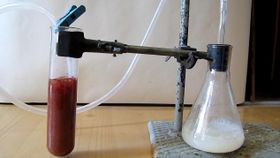Copper(I) acetylide
 When acetylene gas, produced by adding water to calcium carbide, is passed through a solution of copper(I) chloride, the reddish copper(I) acetylide is being produced.
| |
| Names | |
|---|---|
| IUPAC name
Copper(I) acetylide
| |
| Other names
Cuprous acetylide
Dicuprous acetylide | |
| Properties | |
| Cu2C2 | |
| Molar mass | 151.114 g/mol |
| Appearance | Reddish solid |
| Odor | Odorless |
| Melting point | 100 °C (212 °F; 373 K) (explosive decomposition) |
| Boiling point | Decomposes |
| Insoluble | |
| Solubility | Reacts with acids Insoluble in organic solvents |
| Vapor pressure | ~0 mmHg |
| Hazards | |
| Safety data sheet | None |
| Related compounds | |
| Related compounds
|
Silver acetylide |
| Except where otherwise noted, data are given for materials in their standard state (at 25 °C [77 °F], 100 kPa). | |
| Infobox references | |
Copper(I) acetylide or cuprous acetylide, is a chemical compound with the formula Cu2C2. It is a reddish solid, that easily explodes when dry.
Contents
Properties
Chemical
Copper(I) acetylide explodes when dry, but it's more stable when wet. It is one of the very few explosive materials that do not liberate any gaseous products upon detonation.
Thermal decomposition of copper acetylide in vacuum is not explosive and leaves copper metal as a fine powder at the bottom of the flask, while depositing a fluffy very fine carbon powder on the walls. On the basis of spectral data, this powder was claimed to be carbyne C(−C≡C−)nC rather than graphite as expected.
Copper(I) acetylide can be used as catalyst in the preparation of 1,4-butynediol from acetylene gas and formaldehyde.[1]
Physical
Copper(I) acetylide is a reddish powder that is insoluble in water and organic solvents.
Explosive
When dry, copper acetylide is a heat and shock sensitive high explosive, though more thermally sensitive than silver acetylide. It explodes when heated above 100 °C.
Availability
Copper(I) acetylide is not sold due to its instability and has to be made in situ.
Preparation
Copper acetylide can be prepared by bubbling acetylene gas through an aqueous solution of copper(I) chloride and ammonia:[2][3]
- C2H2 (g) + 2 CuCl (s) → Cu2C2 (s) + 2 HCl (g)
The resulting Cu acetylide precipitates as a reddish solid.
Projects
- Pyrotechnic demonstrations
- Synthesis of 1,4-butynediol
- Purify acetylene
Handling
Safety
Copper(I) acetylide is stable when wet, but the dry pure form is highly sensitive to shock and heat, and will explode if disturbed.
Storage
Should not be stored and used up as soon as possible.
Disposal
Can be safely neutralized when wet, by carefully adding and acid, like hydrochloric acid. This produces a copper salt and acetylene gas, so this process must be done outside.
References
- ↑ https://chemistry-europe.onlinelibrary.wiley.com/doi/10.1002/chem.202101932
- ↑ https://www.youtube.com/watch?v=YtTnYCZJw94
- ↑ https://www.youtube.com/watch?v=uPuhAU8SjdE